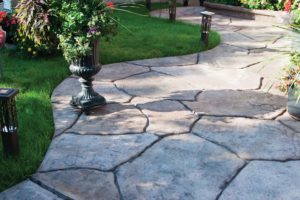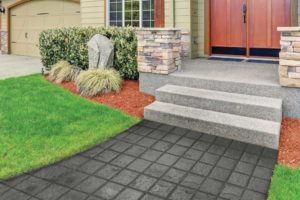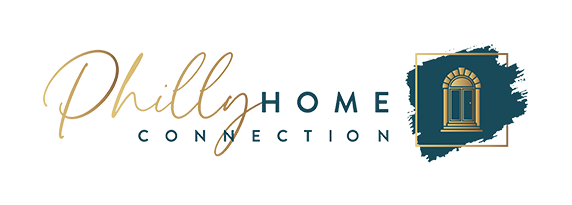Guest Post by Bill Michaels
City dwellers are accustomed to living in the “concrete jungle.” Life can be exciting amidst the many neighborhoods and activities of urban life. The concrete itself is usually pretty boring, though. Philadelphia has unique ways of bringing some life to the drab surface, like its world-famous murals in unexpected places. But there is another way to bring life to this grey blandness: stamped concrete.
Whether you only have a couple square feet of sidewalk or a large patio and driveway, stamped concrete can add some character to your home. With its huge variety of designs, it can fit in any neighborhood. It blends in great in the historic district around Independence Hall or among brick row homes in South Philly. And it’s no less appealing in larger properties along the Main Line.
What Exactly Is Stamped Concrete
Concrete is everywhere in the city, but many people might not be familiar with the term “stamped concrete.” Despite that, it’s possible that you come into contact with it every day.
 In the simplest terms, it’s concrete that is colored then stamped with a design. Over the fifty years or so since it was conceived, a wide variety of stamps have been developed. They can simulate natural-stone tiles, brick, cobblestone, and even wood. In most instances, you end up with a surface that’s more durable yet more economical and easy to care for than its “real” counterpart.
In the simplest terms, it’s concrete that is colored then stamped with a design. Over the fifty years or so since it was conceived, a wide variety of stamps have been developed. They can simulate natural-stone tiles, brick, cobblestone, and even wood. In most instances, you end up with a surface that’s more durable yet more economical and easy to care for than its “real” counterpart.
The process starts out the same as with any concrete project. Your contractor mixes the concrete as normal. The first difference is that a base color is added. This can be done during the mixing or once the concrete is poured. The latter can often provide a longer-lasting tone, since it is concentrated in the surface level.
While the concrete is still wet, pre-made stamps are pressed into it, giving it a pattern. There are several stamps in any set so that a large design can be created. The stamps create a real depth to the design. They texture the whole surface and make deeper impressions that represent the “joints” between the “stones.”
Secondary coloring is then added to create shading and the appearance of mortar or other compound between each element. Once the concrete dries, you’ll have a material that passes for the real thing. Most people will never notice the difference between stamped concrete and the original material!
Not only do you get great looks, you also get a project that’s going to last for years with minimal maintenance. Stamped concrete has all the durability of regular concrete, so with a minimum of care it will last decades. Fresh sealant should be applied every two to three years to help block water penetration.
Other than the resealing, all you need to do is clean your surface. It can be swept off with a regular broom, or power washed if needed. Like most surfaces, it’s important to clean spills as soon as possible. You can use a mild detergent as needed (dishwashing detergent usually works).
When it comes time to shovel snow, be careful not to scrape the surface. If you use a plow (or have a plow company come in) be sure the blade stays about an inch above the surface. Then use a strong plastic shovel to complete the clean up. A metal blade could scratch the sealant, allowing water to get into the concrete itself. Even worse, it could scratch the concrete itself.
Where To Use Stamped Concrete
You can use stamped concrete anywhere that you’d use concrete. Of course, you wouldn’t want to put it somewhere it’s going to be hidden! It’s a fantastic surface that will increase the appeal of any place.
It can be used indoors or out. For instance, it could serve equally well as the floor of your rec room or your back patio. Let’s look at some of the great ways it can be used as an outdoor surface. We’ll give some samples of different designs for each, but remember that it’s your choice – you’re not restricted to just these ideas!
Front Walkway
 No matter how large or small the path to your front door, a great design can make it more welcoming.
No matter how large or small the path to your front door, a great design can make it more welcoming.
Modern architecture tends to feature crisp, straight lines. A design like stacked bond reflects this style. The small tiles with joints that run straight from top-to-bottom and left-to-right create a precise pattern. It also provides a sense of direction and motion that’s great when dealing with your entryway.
Front Porch
Many of Philadelphia’s neighborhoods feature homes with front porches. They’re great for relaxing and socializing with the neighbors. But you want a strong porch that will survive the years.
There are a lot of great looks you could go for here. But since so many homes are built of brick, choosing that design works well as a complement. The design remains true to the original architecture and the heritage of the city.
Driveway
 If you live in an area where you have a driveway, there’s no need to settle for ugly asphalt. Concrete is a great driveway material and the designs of stamped concrete really spruce it up.
If you live in an area where you have a driveway, there’s no need to settle for ugly asphalt. Concrete is a great driveway material and the designs of stamped concrete really spruce it up.
One fantastic design for many areas of the Philadelphia region celebrates the colonial history of the city. If you’re in the Valley Forge area or have a business or home with a driveway or off-street parking in Old City, a cobblestone pattern will fit right in. There are actually great stamps for both the more European-fanned style as well as the stacked style that can still be seen along a few streets in Society Hill.
Garden Path
Moving to the backyard, you might be considering a meandering path around your garden. Stamped concrete won’t disappoint here, either.
Since this is a relaxed space, you might want to consider a design that has an unhurried feel. The look of quarried stone is great for that! Patterned to look like it was hand-carved right out of the quarry, it has irregular edges that line up at varied angles. It looks and feels just as natural as the beautiful flowers and vegetables you’re cultivating.
Patio
 Your patio is another place where you just want to be able to relax, whether sitting alone, having a family cookout, or hosting a party with friends. Since it’s a large space, you don’t want it to seem too busy. Larger tiles with the appearance of natural stone pavers could be exactly what you need.
Your patio is another place where you just want to be able to relax, whether sitting alone, having a family cookout, or hosting a party with friends. Since it’s a large space, you don’t want it to seem too busy. Larger tiles with the appearance of natural stone pavers could be exactly what you need.
This pattern is a great balance between having an unbroken sheet of concrete and going for small tiles which might seem too intense in the space. We recommend a light color to help keep it cool so you’ll be comfortable relaxing here for long periods.
Pool Deck
Finally, we know that Philly summers are hot. No, not hot; they can be downright brutal. Hopping in the pool is a welcome way to cool off and survive the humidity.
A great pool deck is important, too. You want it to stand up to the use but look great at the same time. Wood can be very attractive but it might not be the most obvious choice because it’s not as durable as other materials. However, with stamped concrete, it’s easy to simulate wood planks that look authentic. The lack of splinters will be a dead giveaway, though!
Wood grain gives your pool deck that rustic feel of having escaped the busyness of daily life so you can enjoy a more tranquil moment. You might have to return to the hustle and bustle soon, but these moments at your wonderful poolside are to be treasured!
Conclusion
Improving the looks of your home’s exterior has to include those hard surfaces that are easy to overlook. But stamped concrete offers an affordable, durable, and beautiful way to spruce things up. No matter where you live and what your personal tastes are, you’ll find a pattern that can change these surfaces from dull to delightful.
Bill Michaels is the digital outreach specialist at Patterned Concrete. The company is a pioneer in stamped concrete since 1972. From its Toronto beginnings, the company has grown to have franchises in various cities throughout Canada and the US. More franchise opportunities are available as well!


